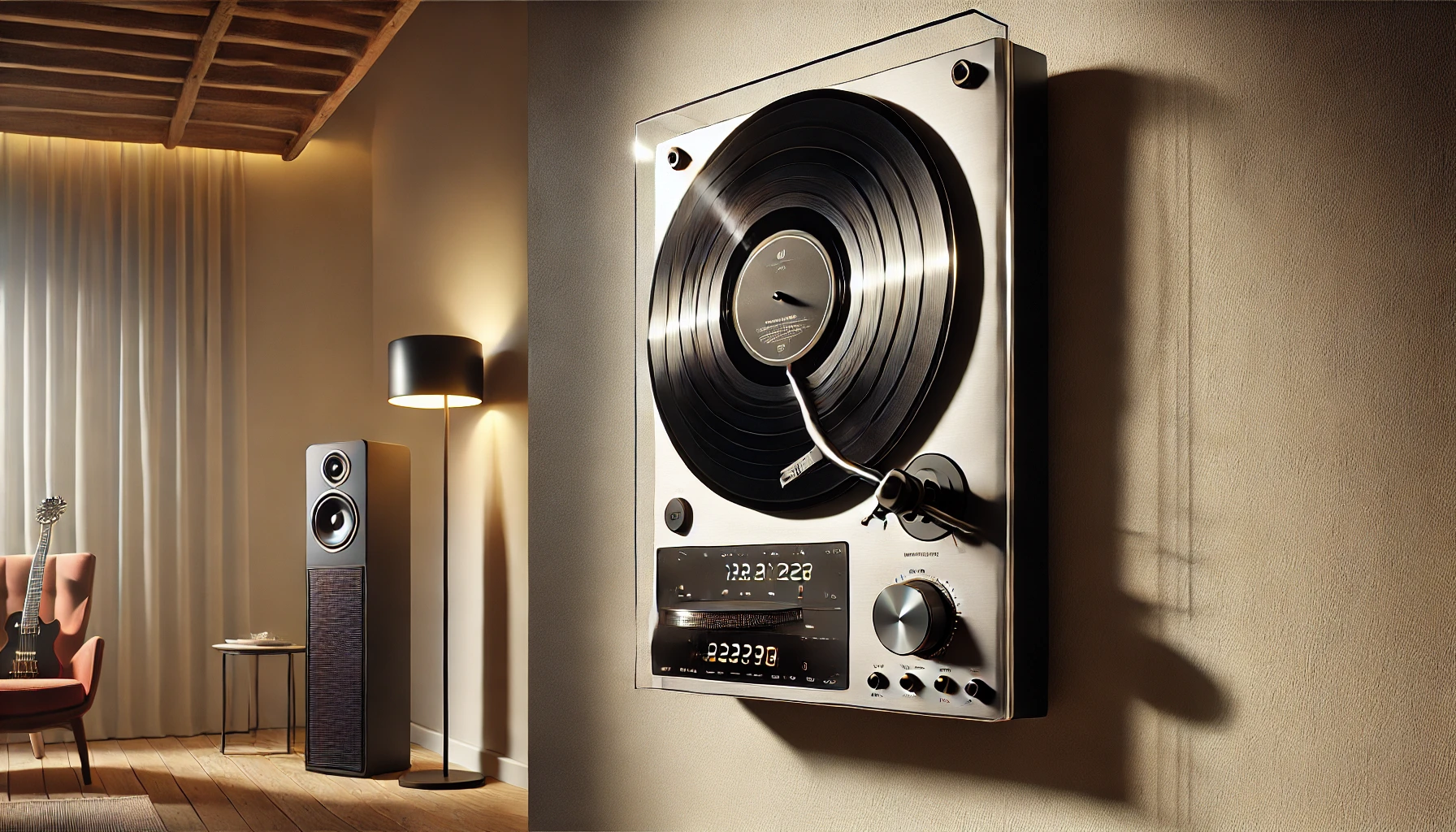Imagine a record player that defies gravity, spinning your vinyl vertically like a mesmerizing musical wall clock. That’s exactly what vertical turntables do, and they’ve been turning heads (and records) in the audio world lately.
As a long-time audio enthusiast and vinyl collector, I’ve seen my fair share of audio gear, but vertical turntables still manage to stop me in my tracks. In this article, we’ll dive into the fascinating world of these upright record players, exploring how they work and whether they’re worth adding to your audio setup.
How Do Vertical Turntables Work?
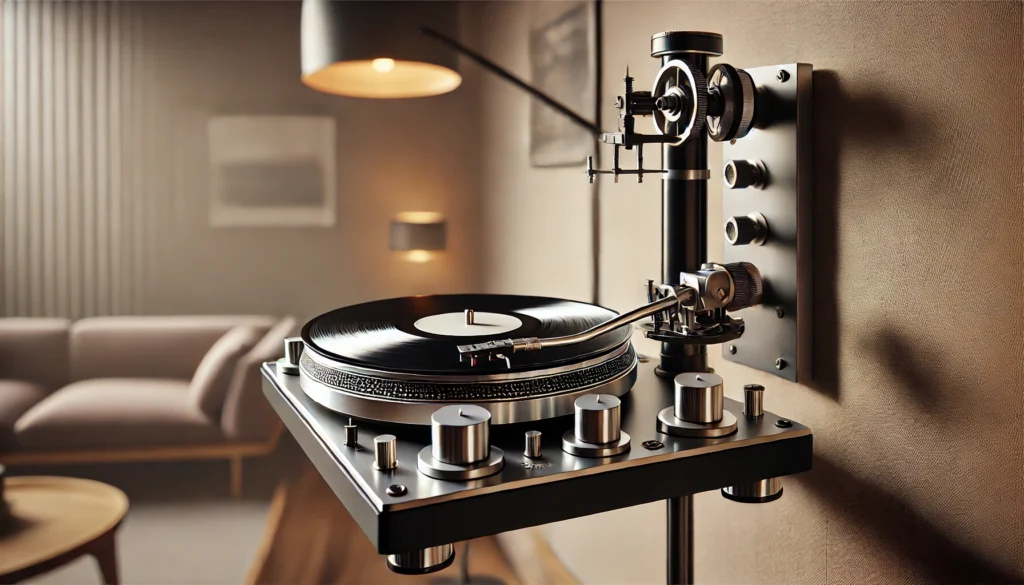
Vertical turntables work by mounting the platter and tonearm assembly perpendicular to the ground, allowing records to spin vertically. The basic components remain similar to traditional turntables, including a motor, platter, tonearm, and cartridge.
However, the orientation is rotated 90 degrees, with specially designed mechanisms to maintain proper tracking force and stylus alignment despite gravity’s pull. The record is typically held in place by a center spindle and sometimes additional clamps or supports to prevent slippage.
While the concept might sound simple, a lot of engineering goes into making sure these vertical players can reproduce sound accurately. Trust me, it’s not as easy as just tipping a regular turntable on its side!
We’ll explore the nitty-gritty details more deeply below, but that’s the gist of how these gravity-defying audio marvels work.
The Mechanics Behind Vertical Turntables
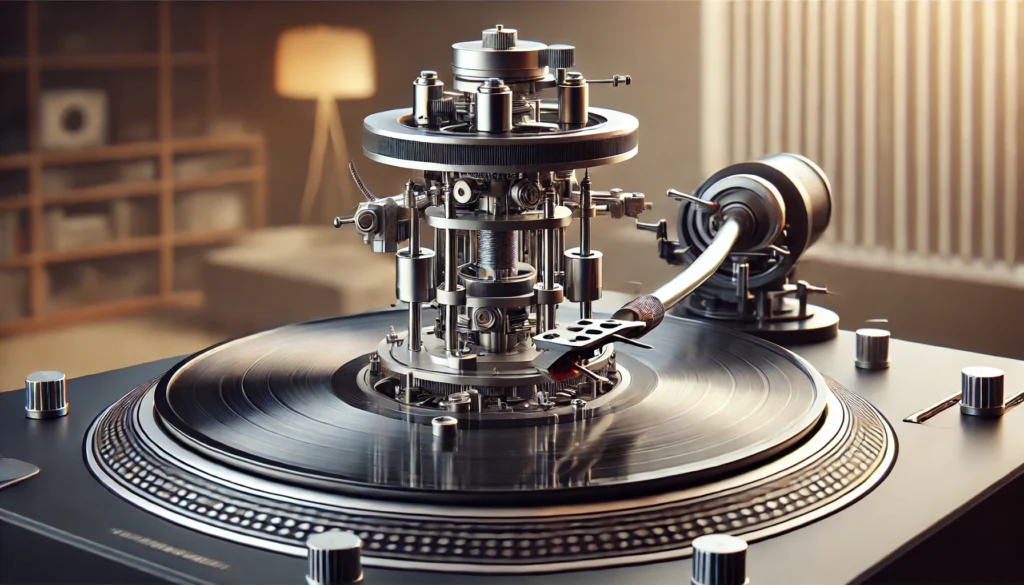
Alright, let’s get into the nuts and bolts of these vertical vinyl spinners. I remember the first time I saw one at a hi-fi show – I was scratching my head trying to figure out how it didn’t just drop the needle and ruin the record!
The key components of a vertical turntable are pretty much the same as their horizontal cousins. You’ve got your platter where the record sits, but it’s mounted vertically.
Then there’s the motor that spins the platter, just like in a regular turntable. The tonearm is where things get tricky – it needs to be carefully balanced to apply the right amount of force horizontally instead of vertically.
And of course, you’ve got your cartridge and stylus that read the grooves in your record, but they’re working against gravity in this setup.
The real magic happens in how these parts are engineered to work together vertically. The tonearm, for instance, often uses a counterweight system that’s more complex than what you’d find in a traditional turntable.
This ensures that the stylus applies the correct pressure to the record grooves despite being sideways.
I once tried to DIY a vertical turntable setup (don’t ask – it didn’t end well for my records), and let me tell you, getting that tracking force right is no joke. Professional vertical turntables use precision engineering to make sure the stylus doesn’t dig too deep into the grooves or skip across them.
Another cool thing about vertical turntables is how they handle the center spindle. Some models have a special clamp or stabilizer that holds the record securely in place.
Others rely on a slightly angled platter that uses gravity to keep the record from sliding off. It’s pretty ingenious when you think about it!
The motor in a vertical turntable also needs some special consideration. In horizontal turntables, the weight of the record and platter helps maintain consistent rotation speed.
But in a vertical setup, that weight is distributed differently. To compensate, vertical turntables often use more powerful motors or advanced speed control systems to ensure your records spin at the perfect 33 1/3 or 45 RPM.
And let’s not forget about the base or mounting system. Vertical turntables need a sturdy foundation to prevent wobbling or vibrations.
Some models come with their own stands, while others are designed to be wall-mounted. Either way, proper isolation is crucial for getting the best sound quality.
Advantages of Vertical Turntables
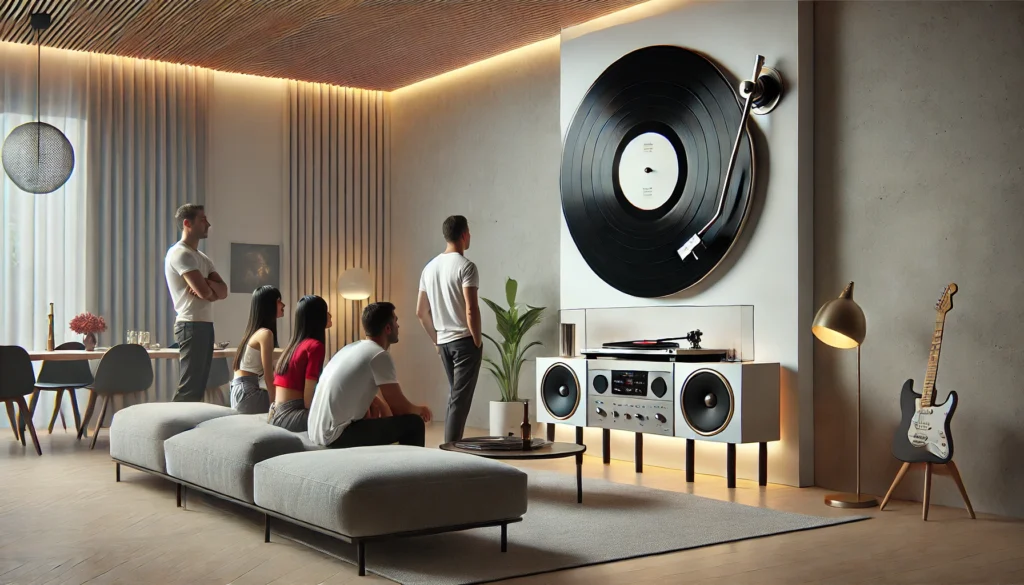
Now, you might be wondering, “Why bother with all this vertical business?” Well, let me tell you, these upright players have some pretty nifty advantages.
First off, there’s the space-saving design. This is probably the biggest selling point.
I live in a tiny apartment, and wall space is much easier to come by than shelf space. Vertical turntables can be mounted on the wall or stood up on a narrow surface, making them perfect for small living spaces.
When I first got mine, I was amazed at how much room it freed up on my audio rack. Suddenly, I had space for more vinyl!
Then there’s the unique aesthetic appeal. Let’s face it, these things look cool as heck.
I’ve had friends come over and gawk at my vertical setup like it’s a piece of modern art. It’s a great conversation starter and can really add a wow factor to your room decor.
I’ve even seen some folks use their vertical turntables as the centerpiece of their living room design. Talk about functional art!
Some folks swear that vertical playback leads to less dust accumulation on the record surface. This one’s a bit controversial, and I’m not entirely convinced, but I have noticed that it’s easier to see and clean dust off a vertical record.
Plus, there’s something satisfying about giving your record a quick brush before sliding it into place on the vertical platter.
And here’s a benefit I didn’t expect – easier record changes. This might sound silly, but I love how easy it is to swap records on a vertical player.
No more awkward reaching around the dust cover – just pop the old one off and slide the new one on! It’s made me more likely to explore different albums in my collection instead of letting the same record play over and over.
One time, I brought my vertical turntable to a friend’s house party, and it was a hit. People were fascinated by watching the record spin vertically, and it definitely added a unique vibe to the evening.
Just be careful if you’ve had a few drinks – trying to put a record on upright can be a bit of a challenge when you’re seeing double!
There’s also something to be said for the novelty factor. In a world where digital streaming is king, having a vertical turntable is a way to celebrate the physicality of vinyl in a whole new way.
It turns the act of playing a record into a visual experience as much as an auditory one.
Challenges and Considerations
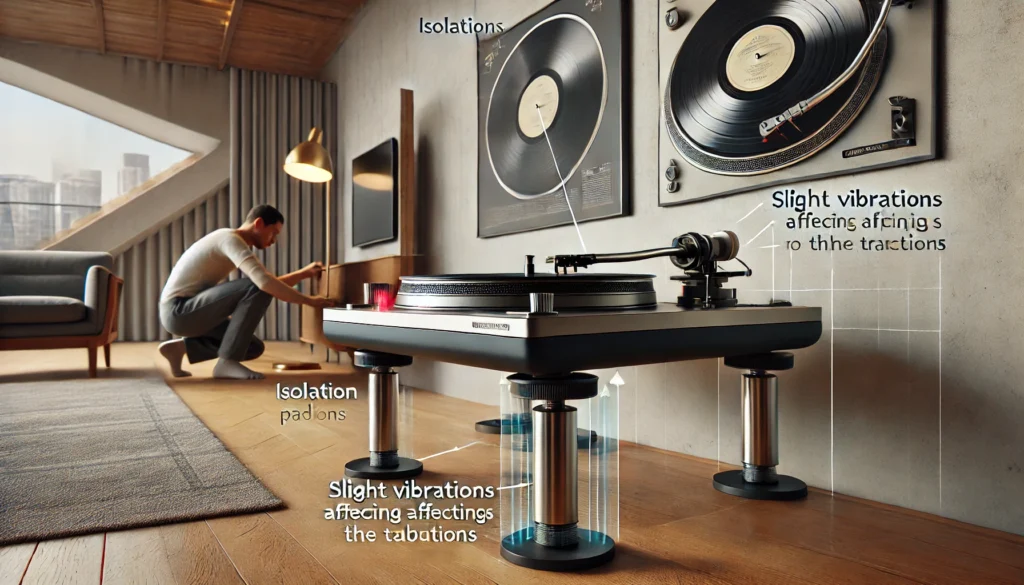
Now, I don’t want to sound like I’m all sunshine and roses about vertical turntables. They do come with their fair share of challenges and considerations.
The biggest issue is gravity’s effect on the stylus and tracking force. Fighting against gravity can potentially lead to increased wear on both your records and the stylus.
High-quality vertical turntables are designed to minimize this, but it’s still a factor to consider. I’ve found that I need to replace my stylus a bit more frequently with my vertical setup compared to my old horizontal player.
Some audiophiles argue that the vertical orientation can affect the cartridge’s ability to track the grooves accurately, potentially leading to subtle changes in sound quality. Personally, I haven’t noticed a huge difference, but your mileage may vary.
I will say that it took me a while to get my vertical turntable dialed in just right, and at first, I did notice some tracking issues, especially on more complex recordings.
Another thing to keep in mind is that not all vertical turntables can handle every record size or weight. I learned this the hard way when I tried to play a heavyweight 180g pressing on my first vertical setup.
Let’s just say it didn’t end well for the turntable or my wallet. Now I’m much more careful about checking the specs of my player against the records I want to play.
Vertical turntables can also be more susceptible to vibrations, especially if wall-mounted. I once had mine set up near a busy street, and I swear I could hear the bass from passing cars in my music!
It took some experimenting with isolation pads and strategic placement to get it just right. If you’re in an apartment or have wooden floors, you might need to put in some extra effort to isolate your vertical turntable properly.
Lastly, while vertical turntables are gaining popularity, there are still fewer options available compared to traditional models. This can make it harder to find one that perfectly fits your needs and budget.
When I was shopping for mine, I found that the price range was pretty wide, with fewer mid-range options than I would have liked.
It’s worth noting that many of these challenges can be mitigated with proper setup and high-quality equipment. But they’re definitely something to keep in mind if you’re considering making the switch to vertical.
Don’t let these challenges scare you off, though – in my experience, the unique benefits of vertical turntables can make the extra effort worthwhile.
Are Vertical Turntables Any Good?
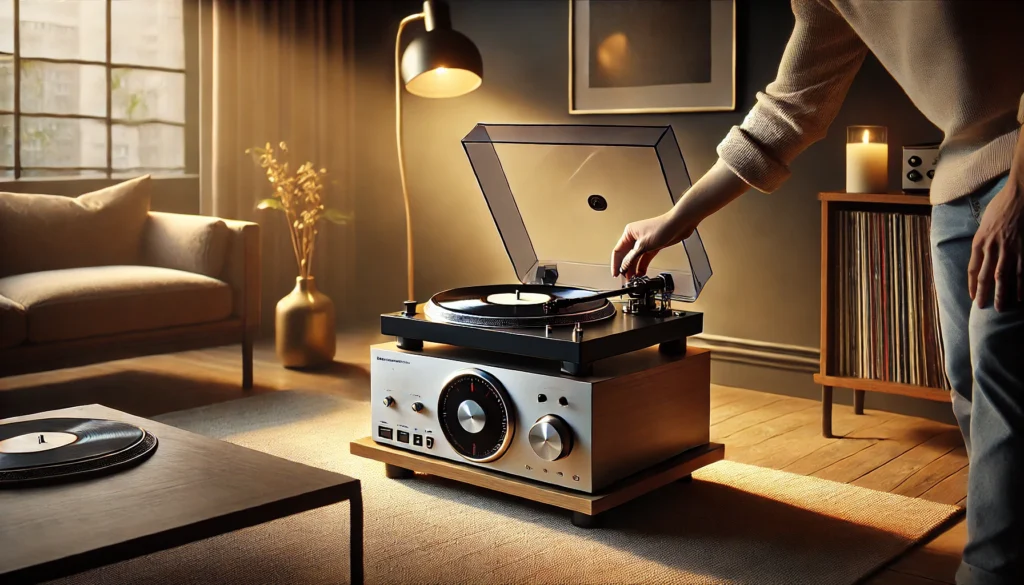
Alright, let’s get down to brass tacks – are these gravity-defying record players actually any good? Well, like most things in the audio world, the answer is: it depends.
In terms of sound quality, a well-designed vertical turntable can perform just as well as its horizontal counterpart. I’ve listened to some vertical setups that absolutely blew me away with their clarity and detail.
However, I’ve also encountered some that left a lot to be desired.
The key factors that determine the quality of a vertical turntable are the engineering and build quality, the cartridge and stylus quality, and proper setup and calibration. A poorly designed vertical turntable will struggle with tracking and could potentially damage your records.
Just like with regular turntables, the cartridge and stylus make a huge difference in sound quality. And proper setup is even more critical for vertical turntables – I once spent an entire weekend tweaking and adjusting my vertical setup to get it just right.
When it comes to user experience, vertical turntables can be a mixed bag. On one hand, they’re often easier to access and can make record changing a breeze.
On the other hand, some people find the vertical orientation less intuitive, especially if they’re used to traditional turntables. I remember the first few times I used mine, I felt a bit like I was learning to play records all over again!
Durability and longevity are areas where vertical turntables might lag behind their horizontal cousins. The added stress on components due to the vertical orientation can potentially lead to more wear and tear over time.
However, high-end models are built to last and can be just as durable as traditional turntables. I’ve had my current vertical setup for about three years now, and it’s still going strong with regular maintenance.
In my experience, vertical turntables can be fantastic if you choose a quality model and set it up correctly. Are they inherently better than horizontal turntables?
Not necessarily. But they can certainly hold their own in terms of performance while offering unique advantages in terms of aesthetics and space-saving.
I’ve found that my vertical turntable has actually rekindled my love for vinyl. There’s something about the ritual of selecting a record, sliding it into place vertically, and watching it spin that makes the whole experience feel fresh and exciting again.
It’s not just about the sound – it’s about the entire experience of enjoying music.
Choosing the Right Vertical Turntable
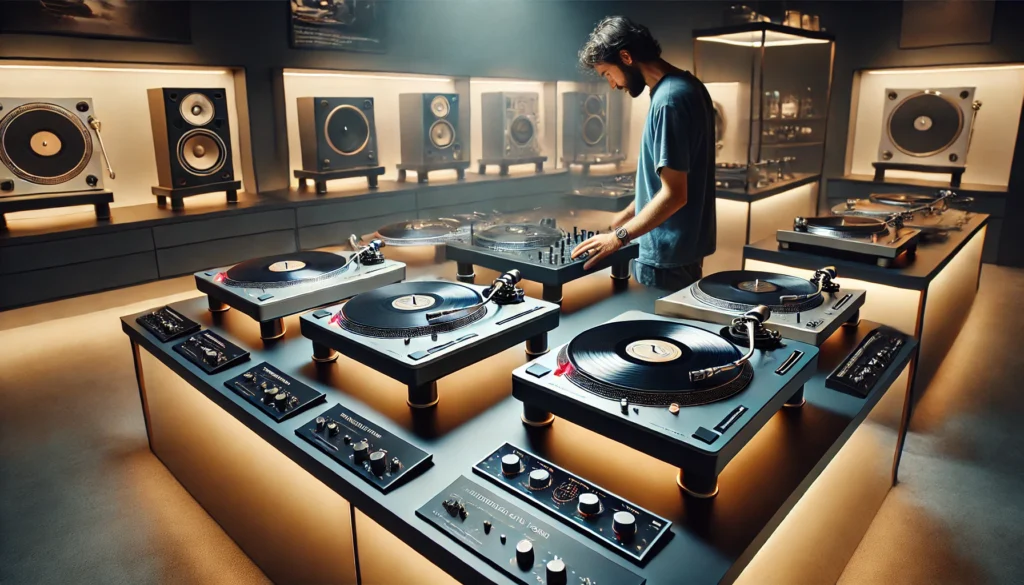
If you’re thinking about taking the plunge into the world of vertical turntables, there are a few key features to look out for. You’ll want to find a model with a robust stabilization system – look for good record clamps or stabilizers to keep your vinyl secure.
Adjustable tracking force is crucial for getting the best sound and protecting your records. Of course, a quality tonearm and cartridge are vital for good sound reproduction.
If you’re planning to wall-mount your turntable, pay extra attention to vibration isolation. And don’t forget to check the size and weight capacity – make sure it can handle all the types of records you want to play.
I’d also recommend looking for a model with a dust cover or some kind of protection system. Vertical records can be dust magnets!
Some popular brands that make decent vertical turntables include Gramovox, Miniot, and Auna. Prices can range from a few hundred bucks for entry-level models to several thousand for high-end audiophile versions.
In my experience, the sweet spot is usually in the mid-range – that’s where you start to see really good build quality and sound without breaking the bank.
When I was shopping for my vertical turntable, I made the mistake of going for the cheapest option I could find. Big mistake!
It sounded terrible and I was constantly worried it was going to drop my precious vinyl. I ended up saving up for a mid-range model, and the difference was night and day.
The sound quality improved dramatically, and I felt much more confident about the safety of my records.
Remember, a turntable is an investment in your music enjoyment. It’s worth spending a bit more to get something that will do justice to your record collection and stand the test of time.
That being said, don’t feel like you need to mortgage your house for a top-of-the-line model. There are plenty of great options in the middle range that can give you fantastic sound and reliability.
Conclusion
Whew! We’ve taken quite a spin through the world of vertical turntables, haven’t we? From their clever mechanics to their unique challenges and considerations, these upright vinyl players are certainly a fascinating twist on traditional audio gear.
So, are vertical turntables worth it? Well, like many things in the world of audio, it really comes down to your personal preferences and needs.
If you’re short on space, love unique design, and are willing to put in the effort to set up and maintain your turntable properly, a vertical model could be a great choice. On the other hand, if you’re a die-hard audiophile who demands the absolute best in sound quality or if you have a large collection of heavy or oddly sized records, you might want to stick with a traditional horizontal turntable.
For me, my vertical turntable has become a beloved part of my audio setup. It’s a conversation starter, a space-saver, and most importantly, it brings my music to life in a way that never fails to put a smile on my face.
Yes, it took some getting used to, and yes, I had to put in some extra effort to get it set up just right. But the unique experience it provides has been well worth it.
Just remember, whether your turntable spins horizontally or vertically, the most important thing is the joy it brings you when you drop that needle and let the music play. At the end of the day, that’s what it’s all about – connecting with your music and enjoying the warm, rich sound that only vinyl can provide.
I’d love to hear about your experiences with vertical turntables! Have you tried one?
Love them? Hate them? Got any tips or tricks to share?
Drop a comment below and let’s keep the conversation spinning!
